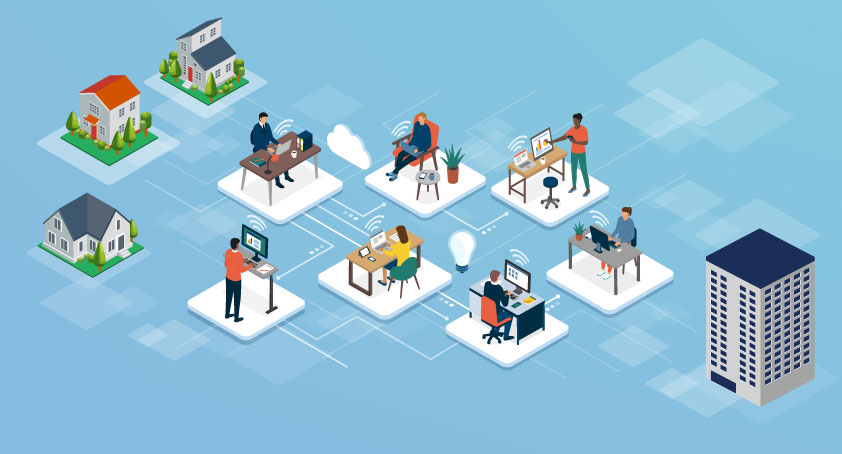Best Ways to Provide 24/7 Support for Your Customers

Just a few years ago, 24/7 support was a premium offering that set you apart from the competition. Now, it’s not only expected, it’s usually demanded by customers.
In fact, Microsoft reports that 54% of global consumers say that they have higher customer service expectations than they did just one year ago.
One of the primary reasons demand for 24/7 support has increased so dramatically is technology. In both their personal and professional lives, modern customers are used to instant results at any time. Fortunately, those same communications advancements also make it easier than ever for businesses to provide 24/7 support.
To help you get started, we’ve put together this handy dandy guide of tools and tactics so you can start providing quality 24/7 support to your customers.
MEETING A NEW AGE OF CUSTOMER EXPECTATIONS
To put it as simply as possible: if you aren’t providing 24/7 support for your customers, you’ve already been left behind. If that sounds harsh, it’s because it is. Customers are pragmatic and ruthless with how they spend their money, so you need any advantage over competitors you can get.
Don’t believe me that things really are that cutthroat? Do believe me but would still like more information? Boy howdy do I have the statistics for you.
75% of modern customers expect their issues to be addressed within five minutes.
80% believe the most important aspects of customer service are convenience, speedy resolution of issues, and competence of support staff.
70% of customers blatantly say they want companies to make support services available 24/7.
For customers whose expectations aren’t being met, the answer is simple: switch to one of your competitors.
For businesses who aren’t meeting the expectations of their customers, the answer is just as simple: start providing 24/7 support!
BENEFITS OF PROVIDING 24/7 SUPPORT FOR YOUR BUSINESS
The primary benefit of providing 24/7 support is that it helps you retain more customers, and therefore drive more revenue. Even if you can’t solve their issue immediately, providing after-hours options to your customers keeps them engaged with your business rather than looking for an alternative.
Additionally, the same inbound and self-service tools that work for support will also enable your sales team to capture leads and move prospects down the funnel 24/7.
You might think extending your customer support hours would heap more work onto your agents. That’s true if you only introduce 24/7 phone support. However, if you implement a multi-channel 24/7 support plan, it will actually empower customers to help themselves and reduce the stress on your team by catching issues before they escalate.
That leaves more time for your support agents to focus on important tickets rather than starting each day with a barrage of frustrated calls and messages.
DIFFERENT WAYS TO PROVIDE 24/7 SUPPORT
Automated Responses - Pre-recorded menu options, automatic text replies, monitored voicemail boxes, etc.
Live Chat Support - Online chat service that connects customers with support staff over a messaging app.
In-House Phone Support - Inbound calls to your support team that receive immediate assistance
Answering Service Support - Inbound calls to an answering service that provides light support and records the details of more difficult cases.
Self-Service Knowledge Base - How-to articles, video tutorials, FAQs, and other collateral that enables customers to solve cases on their own.
Let’s look at each in a bit more detail so you can see which are right for your business.
Automated Responses
Not every support interaction is an ordeal. Sometimes all a customer needs is basic information such as your address or normal business hours. Unfortunately, these calls still tie up your receptionist or support agents just as much as bigger issues.
With automated response tools, you can get everyday questions answered quickly without even involving your employees.
In these cases, providing 24/7 support is as simple as having operational info available for your customers to find across multiple channels. For instance, have an option on your main auto attendant that lists basic company info. While you’re at it, why not add an automatic text reply option that will send a text with your address straight to a caller’s cell phone.
Live Chat Support
Providing live chat on your website and/or user portal gives customers instant access to your support team without the hassle of a phone call or the lag time of email. It’s generally the most convenient option for everyone involved, so it’s no surprise that more and more people use live chat as their go-to way to receive support.
On top of that, live chat reduces ticket resolution times across the board by allowing your support agents to multitask far more than phone calls.
By implementing the right mix of live and automated chat, you can make sure customers always feel like their complaints are being heard without actually needing to have someone on the clock 24/7. For an ultra-futuristic approach, look into bot options in your chat software to provide immediate answers to the questions you know that you get the most.
In-House Phone Support
No matter how many fancy support options you add, or how many convenient alternatives you offer, there will always be customers who only want to call and speak with a real person. To be fair, a phone call will always be the most direct way to explain an issue, and they do admittedly have the highest customer satisfaction rate at 91%.
However, if you plan to provide in-house phone support 24/7, you’ll have to plan ahead with proper scheduling and the additional cost of those working hours.
Modern phone systems like FluentStream provide numerous call forwarding and automatic alert options to make after-hours phone support easier, but it’s still a much more difficult undertaking than other forms of 24/7 support.
Answering Service Support
A solid alternative to 24/7 in-house phone support is to hire an outside answering service.
Generally quite affordable, answering services ensure every customer can speak with a real person. Their representatives will of course be less knowledgeable about the specifics of your business, but their hourly rates can be far more economical than keeping someone on staff 24 hours a day.
With VoIP, there’s no tech wizardry needed to integrate an answering service into your phone system. Calls will just automatically transfer over at the end of your normal business hours.
Self-Service Knowledge Base
When most people think of 24/7 support, they envision late night calls or chats. However, luckily for businesses everywhere, the most effective form of 24/7 support is also the one that requires the least direct effort from your team.
Hosting a knowledge base of tutorial articles, videos, and FAQs makes it easy for your customers to answer questions and solve issues themselves. It also encourages them to learn more about your products and makes them less reliant on your support team over time.
Yes, setting up a quality knowledge base requires a substantial amount of effort up front. All those resources don’t write themselves. And thank goodness because I’d be out of a job… But when done properly, a knowledge base takes an enormous amount of pressure off your support team.
The best part is, there’s no additional planning or budgeting necessary to make a self-service knowledge base available 24/7.
24/7 SUPPORT TIPS & TRICKS
Listen to What Your Customers Want
Different industries have very different customers, which means there’s no one-size-fits-all 24/7 support plan. When deciding which channels are right for your business, start by reviewing common complaints or known gaps in your service. If adding more hours of support availability would improve your customer satisfaction rates, it’s probably worth the investment.
For instance, if your business has global reach, it’s mandatory these days to offer normal business hours support in every timezone where you operate. No matter where you’re headquartered, customers expect help to be available when they’re working.
Or, if you often hear customers complain about long hold times, consider implementing other channels we’ve discussed such as live chat or automated responses.
Too many businesses focus on maintaining the “personal touch” or a real person engaging every customer. That might just be the case for your industry, but more often than not, what customers actually prefer is whichever support channel solves their issue fastest.
Always think of 24/7 support as a competitive advantage rather than an obligation. The quicker you can provide the help people need, the more likely the are to continue choosing your business.
Create a Good Mix of Self-Service and Live Support
Just like how a good teacher accommodates multiple types of learning in their lesson plans, your business needs to accommodate multiple types of customers with your 24/7 support.
It’s unrealistic to think you can provide premium phone support to every caller, every hour of the day. Just like it’s unrealistic to think every problem can be explained away with a video tutorial.
Beyond just the practicalities, 60% of American customers say they prefer self-service tutorials for simple issues, while 33% still get frustrated if they aren’t immediately able to speak with a real person.
If you’re looking for more info on how to deal with difficult customers, we have you covered.
Especially if you're building a 24/7 support plan from scratch, try to integrate multiple live and self-service channels to make sure all your customers can receive their ideal type of support.
Keep a Keen Eye on Your Reporting Metrics
It’s not enough to just add 24/7 support and call it a day. Over time, you need to track the performance of your support channels and see where improvements still need to be made.
Sifting through all those metrics may sound like a full-time job in its own right, but don’t even fret. Modern phone systems like FluentStream make communications reporting a breeze with built-in tracking and automated reports sent straight to your email.
Whatever statistics matter most to your business — average call time, average hold time, total inbound calls as you improve your self-service options — make sure they’re trending in the right direction.
After all, adding 24/7 support doesn’t do much good if your customers don’t find it helpful.
Have more questions about implementing 24/7 support for your business? Want to know how much better a VoIP system from FluentStream can make your customer experience? Let us know at sales@fluentstream.com or by calling 303-GO-CLOUD and selecting Option 1.


